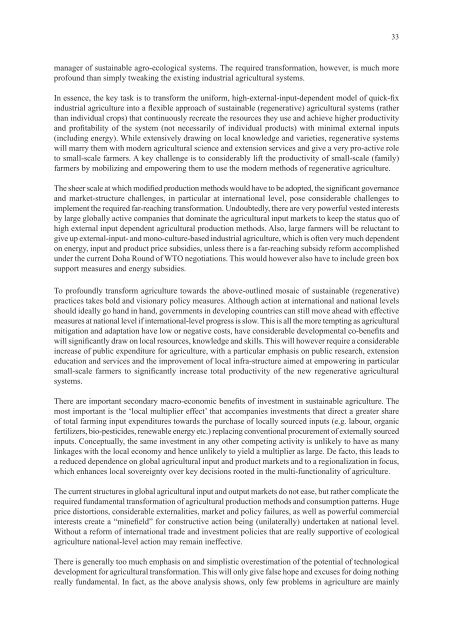Assuring Food Security in Developing Countries under the - Unctad
Assuring Food Security in Developing Countries under the - Unctad
Assuring Food Security in Developing Countries under the - Unctad
Create successful ePaper yourself
Turn your PDF publications into a flip-book with our unique Google optimized e-Paper software.
manager of susta<strong>in</strong>able agro-ecological systems. The required transformation, however, is much more<br />
profound than simply tweak<strong>in</strong>g <strong>the</strong> exist<strong>in</strong>g <strong>in</strong>dustrial agricultural systems.<br />
In essence, <strong>the</strong> key task is to transform <strong>the</strong> uniform, high-external-<strong>in</strong>put-dependent model of quick-fix<br />
<strong>in</strong>dustrial agriculture <strong>in</strong>to a flexible approach of susta<strong>in</strong>able (regenerative) agricultural systems (ra<strong>the</strong>r<br />
than <strong>in</strong>dividual crops) that cont<strong>in</strong>uously recreate <strong>the</strong> resources <strong>the</strong>y use and achieve higher productivity<br />
and profitability of <strong>the</strong> system (not necessarily of <strong>in</strong>dividual products) with m<strong>in</strong>imal external <strong>in</strong>puts<br />
(<strong>in</strong>clud<strong>in</strong>g energy). While extensively draw<strong>in</strong>g on local knowledge and varieties, regenerative systems<br />
will marry <strong>the</strong>m with modern agricultural science and extension services and give a very pro-active role<br />
to small-scale farmers. A key challenge is to considerably lift <strong>the</strong> productivity of small-scale (family)<br />
farmers by mobiliz<strong>in</strong>g and empower<strong>in</strong>g <strong>the</strong>m to use <strong>the</strong> modern methods of regenerative agriculture.<br />
The sheer scale at which modified production methods would have to be adopted, <strong>the</strong> significant governance<br />
and market-structure challenges, <strong>in</strong> particular at <strong>in</strong>ternational level, pose considerable challenges to<br />
implement <strong>the</strong> required far-reach<strong>in</strong>g transformation. Undoubtedly, <strong>the</strong>re are very powerful vested <strong>in</strong>terests<br />
by large globally active companies that dom<strong>in</strong>ate <strong>the</strong> agricultural <strong>in</strong>put markets to keep <strong>the</strong> status quo of<br />
high external <strong>in</strong>put dependent agricultural production methods. Also, large farmers will be reluctant to<br />
give up external-<strong>in</strong>put- and mono-culture-based <strong>in</strong>dustrial agriculture, which is often very much dependent<br />
on energy, <strong>in</strong>put and product price subsidies, unless <strong>the</strong>re is a far-reach<strong>in</strong>g subsidy reform accomplished<br />
<strong>under</strong> <strong>the</strong> current Doha Round of WTO negotiations. This would however also have to <strong>in</strong>clude green box<br />
support measures and energy subsidies.<br />
To profoundly transform agriculture towards <strong>the</strong> above-outl<strong>in</strong>ed mosaic of susta<strong>in</strong>able (regenerative)<br />
practices takes bold and visionary policy measures. Although action at <strong>in</strong>ternational and national levels<br />
should ideally go hand <strong>in</strong> hand, governments <strong>in</strong> develop<strong>in</strong>g countries can still move ahead with effective<br />
measures at national level if <strong>in</strong>ternational-level progress is slow. This is all <strong>the</strong> more tempt<strong>in</strong>g as agricultural<br />
mitigation and adaptation have low or negative costs, have considerable developmental co-benefits and<br />
will significantly draw on local resources, knowledge and skills. This will however require a considerable<br />
<strong>in</strong>crease of public expenditure for agriculture, with a particular emphasis on public research, extension<br />
education and services and <strong>the</strong> improvement of local <strong>in</strong>fra-structure aimed at empower<strong>in</strong>g <strong>in</strong> particular<br />
small-scale farmers to significantly <strong>in</strong>crease total productivity of <strong>the</strong> new regenerative agricultural<br />
systems.<br />
There are important secondary macro-economic benefits of <strong>in</strong>vestment <strong>in</strong> susta<strong>in</strong>able agriculture. The<br />
most important is <strong>the</strong> ‘local multiplier effect’ that accompanies <strong>in</strong>vestments that direct a greater share<br />
of total farm<strong>in</strong>g <strong>in</strong>put expenditures towards <strong>the</strong> purchase of locally sourced <strong>in</strong>puts (e.g. labour, organic<br />
fertilizers, bio-pesticides, renewable energy etc.) replac<strong>in</strong>g conventional procurement of externally sourced<br />
<strong>in</strong>puts. Conceptually, <strong>the</strong> same <strong>in</strong>vestment <strong>in</strong> any o<strong>the</strong>r compet<strong>in</strong>g activity is unlikely to have as many<br />
l<strong>in</strong>kages with <strong>the</strong> local economy and hence unlikely to yield a multiplier as large. De facto, this leads to<br />
a reduced dependence on global agricultural <strong>in</strong>put and product markets and to a regionalization <strong>in</strong> focus,<br />
which enhances local sovereignty over key decisions rooted <strong>in</strong> <strong>the</strong> multi-functionality of agriculture.<br />
The current structures <strong>in</strong> global agricultural <strong>in</strong>put and output markets do not ease, but ra<strong>the</strong>r complicate <strong>the</strong><br />
required fundamental transformation of agricultural production methods and consumption patterns. Huge<br />
price distortions, considerable externalities, market and policy failures, as well as powerful commercial<br />
<strong>in</strong>terests create a “m<strong>in</strong>efield” for constructive action be<strong>in</strong>g (unilaterally) <strong>under</strong>taken at national level.<br />
Without a reform of <strong>in</strong>ternational trade and <strong>in</strong>vestment policies that are really supportive of ecological<br />
agriculture national-level action may rema<strong>in</strong> <strong>in</strong>effective.<br />
There is generally too much emphasis on and simplistic overestimation of <strong>the</strong> potential of technological<br />
development for agricultural transformation. This will only give false hope and excuses for do<strong>in</strong>g noth<strong>in</strong>g<br />
really fundamental. In fact, as <strong>the</strong> above analysis shows, only few problems <strong>in</strong> agriculture are ma<strong>in</strong>ly<br />
33

















